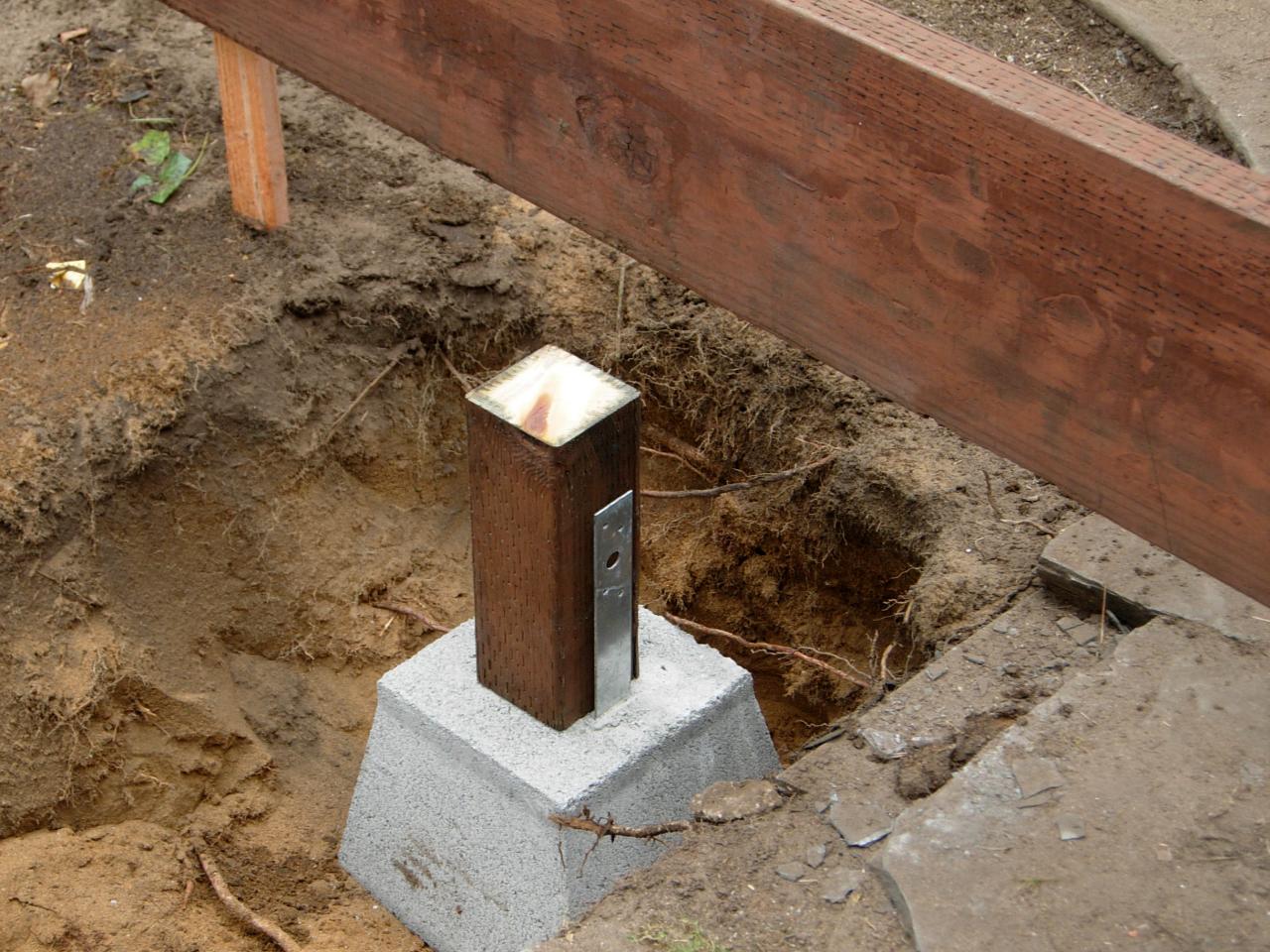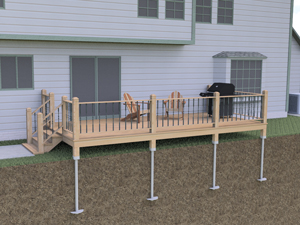Make The Most Of the Life-span of Your Deck With Strong and dependable Footings
As property owners, we invest a significant amount of time and sources right into producing the ideal outdoor room. A deck is typically the centerpiece of that room, supplying a location to relax, captivate, and enjoy the charm of nature. Nonetheless, in order to fully make the most of the life-span of your deck, it is important to make sure that it is built on strong and dependable footings. These grounds develop the structure of your deck, offering stability and support, and are usually the distinction in between a deck that lasts for decades and one that needs continuous repair services. In this discussion, we will explore the value of reliable grounds, the different sorts of solid ground materials, appropriate installation techniques, and how to maintain and examine your deck's grounds to avoid damages. So, whether you are in the process of looking or building a brand-new deck to boost the long life of your existing one, join us as we reveal the secrets to a deck that stands the test of time.
Relevance of Reputable Grounds
When it comes to making the most of the life-span of your deck,The relevance of trusted footings can not be overemphasized. The footings work as the structure whereupon the whole structure rests, supplying security and assistance. Without a strong ground, the deck is prone to changing, sinking, and also collapse, which can substantially lower its life-span and present safety threats.

Selecting the best sort of footing is likewise vital. One of the most typical types consist of concrete footings, helical piers, and sonotubes. Factors such as dirt problems, environment, and the dimension of the deck will establish the most appropriate alternative. Working with an expert to assess the soil, design the grounds, and make certain appropriate installation is extremely advised.
Investing in dependable footings might involve additional cost and effort upfront, but it is a worthwhile investment that will add to the lasting toughness and safety and security of your deck. By ensuring a strong foundation, you can enjoy your deck for years to find, recognizing that it is constructed to withstand the examination of time.
Types of Strong Footing Materials
To make sure the stability and long life of your deck, it is necessary to take into consideration the various kinds of strong ground materials offered. The selection of footing product is essential as it supplies the needed assistance and stability to withstand the weight and load of the deck structure.
One common and reputable material made use of for deck grounds is concrete. Concrete footings are resilient and give outstanding security. They can be put directly into the ground or make use of precast concrete footings for less complicated installation. An additional alternative is helical piers, which are steel shafts with helical plates that are screwed into the ground. These piers use excellent load-bearing capacity and can be utilized in numerous dirt conditions.
For areas with inadequate dirt problems, such as extensive or loose dirts, a ground system that makes use of steel or composite piers might be favored. Deck Footings. These piers are driven deep into the ground to get to steady dirt layers, ensuring the stability of the deck
In many cases, deck footings can also be built utilizing treated lumber. Nonetheless, it is essential to guarantee that the lumber is correctly dealt with to stand up to rot and degeneration brought on by exposure to wetness and bugs.
When choosing a footing material for your deck, it is important to take into consideration factors such as dirt problems, climate, and regional building regulations. Consulting with an expert service provider or architectural designer can aid establish the most ideal ground material for your specific deck project.
Proper Setup Strategies for Grounds
Taking into consideration the importance of ensuring security and sturdiness for your deck, it is vital to understand the correct installment methods for footings. The success of your deck task click for info relies greatly on the honesty of its foundation, which is why following the proper installation methods is essential.
Primarily, it is necessary to figure out the proper dimension and deepness of the footings based upon the design and tons requirements of your deck. This info can be gotten from building codes or via consultation with an architectural engineer. As a general regulation, grounds should go to the very least 12 inches in size and prolong below the frost line to avoid clearing up or shifting.
When the measurements are developed, the following action is excavation. Digging the openings for the footings need to be made with accuracy, making certain they are deep sufficient and have a level base. Deck Footings. This will certainly give a stable base for the grounds
To better boost the stability of the footings, it is recommended to use a concrete blend with a toughness of at the very least 3,000 psi. This will certainly guarantee the footings can hold up against the weight and pressures exerted by the deck.
During installation, it is necessary to maintain the footings level and lined up appropriately. This can be attained by utilizing a degree and string lines to direct the positioning of each ground.
Preserving and Evaluating Your Deck's Grounds
Routine maintenance and detailed inspections are important for guaranteeing the long-lasting stability and security of your deck's grounds. With time, grounds can give in to tear and wear, climate condition, and soil activity, which can jeopardize their architectural stability. To make best use of the lifespan of your deck's grounds, it is essential to carry out a routine upkeep routine and conduct detailed evaluations.

Additionally, it is essential to evaluate footings for any kind of indicators of damage or damage. This includes monitoring for splits, divides, or crumbling concrete, along with any indications of motion or negotiation. Any type of concerns need to be attended to promptly to avoid more damage and guarantee the stability of the deck.
Furthermore, it is advised to inspect the bordering dirt for any type of indications of disintegration or moving. Soil activity can influence the security of the grounds, so it is important to resolve any soil-related issues promptly.
Indications of Footing Damage and Just How to Address Them
Footing damage can posture severe dangers to the stability and safety of your deck, making it necessary to quickly identify and address any type of indications of degeneration. One of one of the most typical indications of footing try this damage is sinking or settling of the deck. This can take place because of dirt erosion, poor footings, or poor building practices. If you notice that your deck is irregular or leaning, it is important to take prompt activity to stop further damages. Another indication of footing damage is cracking or collapsing of the concrete footings. This can be triggered by freeze-thaw cycles, extreme dampness, or bad quality concrete. If you observe any fractures or deterioration in the grounds, it is important to have them checked and repaired by a professional. Furthermore, if you see any motion or changing of the deck, such as a deck that feels unpredictable when strolled on or wobbles when weight is used, it might be a sign of footing damages. In such instances, it is suggested to speak with an architectural engineer or a professional contractor to assess the level of the damages and determine the suitable strategy. Keep in mind, attending to ground damage quickly can aid make certain the lasting stability and security of your deck.
Conclusion
In conclusion, making certain the integrity and stamina of footings is vital for making best use of the lifespan of your deck. By making use internet of strong footing materials and appropriately mounting them, you can protect against damage and preserve the security of your deck.
These footings create the foundation of your deck, giving security and assistance, and are frequently the distinction in between a deck that lasts for years and one that requires continuous repair work. In this discussion, we will explore the value of trustworthy grounds, the various kinds of strong ground materials, correct installment strategies, and exactly how to preserve and check your deck's footings to avoid damages.Normal maintenance and complete inspections are important for making certain the long-lasting stability and security of your deck's grounds. Keep in mind, dealing with footing damages promptly can help ensure the long-term stability and security of your deck.
By utilizing solid footing materials and correctly installing them, you can protect against damage and preserve the security of your deck.
Comments on “Deck Footings Unveiled: Comprehending the Key Parts of a Reputable Deck Framework”